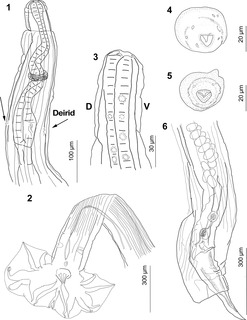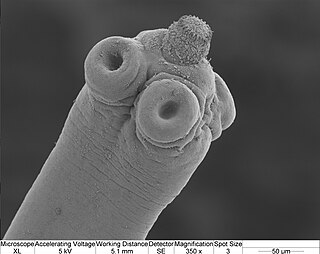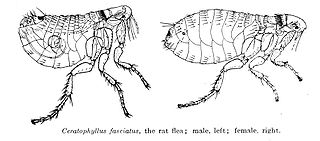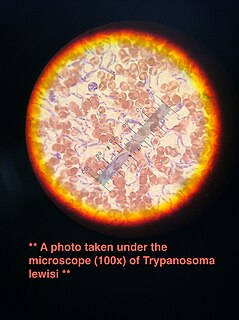 W
WAngiostrongylus cantonensis is a parasitic nematode (roundworm) that causes angiostrongyliasis, the most common cause of eosinophilic meningitis in Southeast Asia and the Pacific Basin. The nematode commonly resides in the pulmonary arteries of rats, giving it the common name rat lungworm. Snails are the primary intermediate hosts, where larvae develop until they are infectious.
 W
WAngiostrongylus costaricensis is a species of parasitic nematode and is the causative agent of abdominal angiostrongyliasis in humans. It occurs in Latin America and the Caribbean.
 W
WCapillaria hepatica is a parasitic nematode which causes hepatic capillariasis in rodents and numerous other mammal species, including humans. The life cycle of C. hepatica may be completed in a single host species. However, the eggs, which are laid in the liver, must mature outside of the host body prior to infecting a new host. So the death of the host in which the adults reach sexual maturity, either by being eaten or dying and decomposing, is necessary for completion of the life cycle.
 W
WCuterebra, or rodent bots, is a genus of flies that attack rodents and similar animals.
 W
WFahrenholzia pinnata is a species of louse. Its typical host is a rodent.
 W
WGuerrerostrongylus is a genus of nematode worms. Species of Guerrerostrongylus infect mostly the digestive tract of sigmodontine and caviomorph rodents from South America. The genus is part of the subfamily Nippostrongylinae.
 W
WHeligmosomoides polygyrus, previously named Nematospiroides dubius, is a naturally occurring intestinal roundworm of rodents. It belongs to the family Trychostrongylidae, and male and female worms are morphologically distinguishable. The parasite has a direct lifecycle, with its larval form being the infective stage. H. polygyrus has the ability to establish chronic infections in rodents and alter host immune responses. This nematode is widely used as a gastrointestinal parasitic model in immunological, pharmacological, and toxicological studies.
 W
WHymenolepis microstoma, also known as the rodent tapeworm, is an intestinal dwelling parasite. Adult worms live in the bile duct and small intestines of mice and rats, and larvae metamorphose in the haemocoel of beetles. It belongs to the genus Hymenolepis; tapeworms that cause hymenolepiasis. H. microstoma is prevalent in rodents worldwide, but rarely infects humans.
 W
WHystrichopsylla schefferi, also known as the mountain beaver flea and giant mountain beaver flea, is a parasitic nearctic insect belonging to the order Siphonaptera, the "siphon-wingless" (fleas). With an adult body length of as much as 0.5 inches (13 mm), it is the largest living flea in the world, and is native to the American Northwest. Though most members of the genus Hystrichopsylla are not strongly associated with any particular host animal and will parasitize insectivores and rodents generally, H. schefferi is monoxenously associated with the mountain beaver with which its range is coterminous. The fleas of the family Hystrichopsyllidae, along with the family Pulicidae, are the oldest of fleas in evolutionary history. H. schefferi can be distinguished from the very similar and closely related species Hystrichopsylla gigas dippiei by the number of spines in the pronotal comb, as H. g. dippiei has 36 and H. schefferi has 46.
 W
WLaelaps is a genus of common parasitic mites in the family Laelapidae. Species, with their hosts, include:Laelaps acuminata – Oecomys Laelaps agilis – Rattus Laelaps alaskensis – Blarina, Dicrostonyx, Lemmiscus, Lemmus, Microtus, Mustela, Myodes, Myotis, Napaeozapus, Ochrotomys, Ondatra, Onychomys, Parascalops, Peromyscus, Phenacomys, Poliocitellus, Sorex, Synaptomys, Thomomys Laelaps boultoni – Neacomys, Sigmodon, Oligoryzomys, Oecomys, Heteromys Laelaps castroi – Oligoryzomys Laelaps clethrionomydis – Microtus, Myodes Laelaps conula – Rhipidomys Laelaps crinigera – Oryzomyini Laelaps dearmasi – Zygodontomys Laelaps differens Laelaps echidnina – Rattus, Didelphis, Sigmodon, Mus, Peromyscus, Sylvilagus Laelaps evansi – Neofiber Laelaps exceptionalis – "wild rat" Laelaps flexa – Microryzomys Laelaps giganteus – Lemniscomys Laelaps incilis – Microtus, Neotamias, Peromyscus Laelaps kochi – Blarina, Corynorhinus, Dicrostonyx, Dipodomys, Glaucomys, Microtus, Mustela, Myodes, Napaeozapus, Neotamias, Neovison, Neurotrichus, Ondatra, Peromyscus, Phenacomys, Sigmodon, Sorex, Synaptomys, Tamias, Zapus Laelaps lavieri – Mus Laelaps lemmi – Lemmus Laelaps liberiensis – Mastomys Laelaps manguinhosi – Holochilus, Nectomys, Neusticomys, and various other mammals Laelaps mazzai – Calomys, Oligoryzomys Laelaps multispinosa – Castor, Didelphis, Microtus, Mustela, Neovison, Ondatra, Peromyscus, Procyon Laelaps muricola – Mastomys Laelaps muris – Microtus, Ondatra Laelaps navasi – Oryzomyini Laelaps nuttalli – Mus, Ochrotomys, Peromyscus, Rattus, Sciurus Laelaps ovata – Nephelomys Laelaps paulistanensis – Rhipidomys, Oryzomyini Laelaps pilifer – Oryzomyini Laelaps spicata – Oryzomyini Laelaps stupkai – Synaptomys Laelaps surcomata – Rhipidomys Laelaps thori
 W
WA variety of parasites have been recorded from the marsh rice rat, a semiaquatic rodent found in the eastern and southern United States, north to New Jersey and Kansas and south to Florida and Texas, and in Tamaulipas, far northeastern Mexico. Some of these parasites are endoparasites, internal parasites, while others are ectoparasites, external parasites.
 W
WNippostrongylus brasiliensis is a type of nematode/gastrointestinal roundworm or nematode that infects rodents, primarily rats. This worm is a widely studied parasite due to its simple lifecycle and its ability to be used in animal models. Its lifecycle similar to the human hookworms Necator americanus and Ancylostoma duodenale which includes five molting stages to become sexually mature.
 W
WNosopsyllus fasciatus, the northern rat flea, is a species of flea found on domestic rats and house mice. Northern rat fleas are external parasites, living by hematophagy off the blood of rodents. It is the most widely spread of its genus, having originated in Europe, but has been transported to temperate regions all over the world.
 W
WOdilia is a genus of nematode worms established by Marie-Claude Durette-Desset in 1973 that infect mostly murid rodents of the Australasian region (species of Melomys, Rattus and Uromys from mainland Australia and Tasmania.
 W
WThe Oriental rat flea, also known as the tropical rat flea, is a parasite of rodents, primarily of the genus Rattus, and is a primary vector for bubonic plague and murine typhus. This occurs when a flea that has fed on an infected rodent bites a human, although this flea can live on any warm blooded mammal.
 W
WOrnithonyssus bacoti is a hematophagous parasite. It feeds on blood and serum from many hosts. O. bacoti can be found and cause disease on rats and wild rodents most commonly, but also small mammals and humans when other hosts are scarce. Outbreaks tend to occur in older, less maintained buildings. The mite, however, can travel several hundred feet on its own if necessary to find a host and can survive for extended periods of time without a host. This, along with the nonspecific dermatitis it causes, can prevent accurate and fast diagnosis of rat mite dermatitis. The scarcity of reports, due in part to misdiagnosis and also the mildness of its symptoms, makes the disease seem less common than it is. The tropical rat mite can be found in both temperate and tropical regions or rather all continents except the Arctic and Antarctic.
 W
WPlasmodium berghei is a species in the genus Plasmodium subgenus Vinckeia.
 W
W W
WSchistosoma malayensis is a schistosome parasite. It was first described in 1988 in Peninsular Malaysia and appears to be a zooenotic infection. The species is named after the country of Malaysia. The natural vertebrate host is van Müller's rat. The intermediate hosts are aquatic snails, Robertsiella kaporenisis. Among Robertsiella kaporenisis are two other Roberstiella species.
 W
WToxoplasma gondii is an obligate intracellular parasitic protozoan eukaryote that causes the infectious disease toxoplasmosis. Found worldwide, T. gondii is capable of infecting virtually all warm-blooded animals, but felids, such as domestic cats, are the only known definitive hosts in which the parasite may undergo sexual reproduction.
Trichinella spiralis is a viviparous nematode parasite, occurring in rodents, pigs, bears, hyenas and humans, and is responsible for the disease trichinosis. It is sometimes referred to as the "pork worm" due to it being typically encountered in undercooked pork products. It should not be confused with the distantly related pork tapeworm.
 W
WTrypanosoma lewisi is a globally distributed parasite of Rattus species and other rodents such as mice, and of kangaroo rats in America. Among these host species were two endemic species of rats: Rattus macleari and Rattus nativitatis. Both are now believed to be extinct. It is not very clear whether or not the same parasite infected both species. However, both parasites are very similar. The northern rat flea, Nosopsyllus fasciatus acts as the vector for the parasite, harboring the epimastigote stage in its midgut. The trypomastigote is the stage that is present in the main host, the rodent. The epimastigote form attaches itself to the rectum of the insect using its flagella to burrow through the rectal walls. The parasites also appear in the flea's feces. Ingestion of either the flea or its feces during grooming infects the host rodent with the parasites. T. lewisi is normally non-pathogenic but is known to have produced fatal infections in rats.